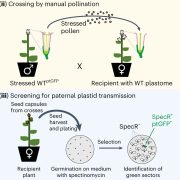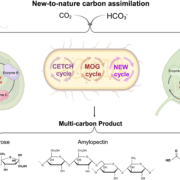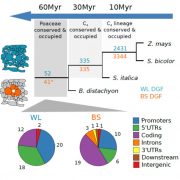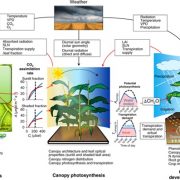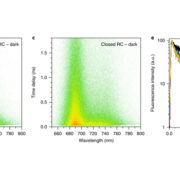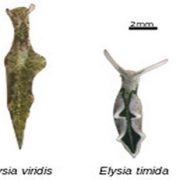Thylakoid membrane remodelling during the dark-to-light transition
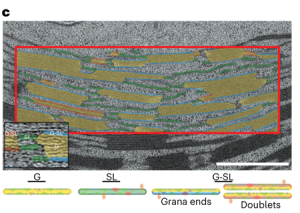 In the dark, plants modify thylakoid stacking to alter electron transport and reduce photodamage. More photosystem II (PSII) is located in thylakoids within stacked grana, which promotes cyclic electron transport. Upon light exposure, there is granal unstacking, which increases the amount of linear electron transport for carbon assimilation. Here Garty et al. used freeze fracture cryo scanning electron microscopy and transmission electron microscopy to study thylakoid membrane structure during the dark-to-light transition at high resolution. They categorized thylakoids in wild type Arabidopsis thaliana leaf chloroplasts into four groups – singular thylakoids exposed to the stroma on both sides, thylakoids within a granal stack, those on the edge of a granal stack and those in a thylakoid pair, which they called ‘stacked thylakoid doublets’. On the dark-to-light transition, the percentage of thylakoids in granal stacks decreased from 44% to 33%, whilst the percentage of stacked thylakoid doublets increased from 13% to 26%. Modelling these changes showed that the formation of stacked thylakoid doublets increased the fraction of PSII in proximity to PSI from 0.44 to 0.59, this allowed for more efficient linear electron transport. Hence, this study provides the first observations of stacked thylakoid doublets which are an ideal platform for linear electron transport. (Summary by Rose McNelly @Rose_McN) Nature Plants 10.1038/s41477-024-01628-9
In the dark, plants modify thylakoid stacking to alter electron transport and reduce photodamage. More photosystem II (PSII) is located in thylakoids within stacked grana, which promotes cyclic electron transport. Upon light exposure, there is granal unstacking, which increases the amount of linear electron transport for carbon assimilation. Here Garty et al. used freeze fracture cryo scanning electron microscopy and transmission electron microscopy to study thylakoid membrane structure during the dark-to-light transition at high resolution. They categorized thylakoids in wild type Arabidopsis thaliana leaf chloroplasts into four groups – singular thylakoids exposed to the stroma on both sides, thylakoids within a granal stack, those on the edge of a granal stack and those in a thylakoid pair, which they called ‘stacked thylakoid doublets’. On the dark-to-light transition, the percentage of thylakoids in granal stacks decreased from 44% to 33%, whilst the percentage of stacked thylakoid doublets increased from 13% to 26%. Modelling these changes showed that the formation of stacked thylakoid doublets increased the fraction of PSII in proximity to PSI from 0.44 to 0.59, this allowed for more efficient linear electron transport. Hence, this study provides the first observations of stacked thylakoid doublets which are an ideal platform for linear electron transport. (Summary by Rose McNelly @Rose_McN) Nature Plants 10.1038/s41477-024-01628-9


